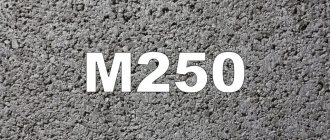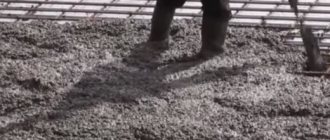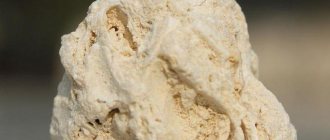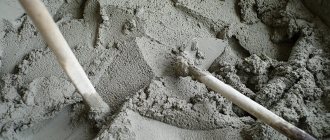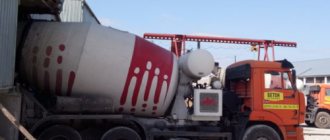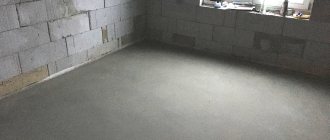Concrete M300 is the most popular and popular brand of material, which is used in a variety of types of repair and construction work: pouring the foundations of private houses, piles, beams, stairs, fences, etc. Thanks to the optimal ratio of cost and technical characteristics, and the ability to prepare it yourself, concrete M 300 is the most common brand today.
The main advantages of the mixture:
- High level of durability
- Resistance to a variety of external negative factors - sudden temperature changes, frost, heat, which makes concrete 300 suitable for use in a variety of climatic zones
- Good resistance to moisture
- Optimal level of thermal conductivity
- Durability of structures and buildings in the construction of which grade 300 concrete was used
- Fire resistance - concrete does not melt or burn
- Environmentally friendly and completely safe for people - there are no toxic substances or harmful additives in the composition
- Relatively low cost
- Possibility of improving properties - the M300 concrete recipe allows for the introduction of various additives, plasticizers, etc.
Characteristics of concrete M300
To understand why M300 concrete is so good, its characteristics should be analyzed in more detail. It is thanks to its strength, density, and resistance to various influences that concrete grade M 300 is considered an almost universal material.
All characteristics are established by GOST, as well as the ratio of components in the composition.
Main properties of M300 concrete:
- Density
concrete M300 is 1.85-2.5 t/m3, which depends on the fraction and type of crushed stone used. Thanks to this indicator, the material can be used for the construction of structures that are constantly subject to force loads.
- Strength
– M300 concrete demonstrates class B22-B22.5 (which class depends on the recipe).
- Frost resistance
– F150 (number of freezing/thawing cycles, can reach F200 when adding plasticizers and changing the recipe).
- Moisture resistance
– W5-W6 (quite high for a solution)
- Mobility
(mortar workability) – P1-P5 (a higher level of workability can be achieved by introducing plasticizers into the M300 concrete composition)
- Specific gravity
concrete M300 - 1800-2500 kg/m3: if the solution is prepared on limestone, the weight is from 1800 to 1900 kilograms, if on granite - from 2000 to 2500. Concrete, the specific gravity of which is less than 1800, is considered defective.
Specific gravity table
| Concrete grade | Specific gravity of 1m 3 concrete |
| Concrete M100 | 2494 kg |
| Concrete M200 | 2432 kg |
| Concrete M250 | 2348 kg |
| Concrete M300 | 2389 kg |
| Concrete M350 | 2502 kg |
| Concrete M400 | 2376 kg |
| Concrete M500 | 2298 kg |
Now you know how much a cube of concrete of a particular brand weighs. Just keep in mind that it is possible to achieve exact compliance with the characteristics during its factory production.
Strength classes
The concrete grade M300 demonstrates a fairly high strength class. The class is the most important characteristic of the solution and directly affects the scope of use of the mixture, the durability and reliability of the structure, and the ability to resist different loads. When making concrete, the class and grade must be taken into account.
The marking is determined by the current GOST, the brand is designated by the capital letter M and an indicator in numbers, which reflects the maximum compression pressure that the material can withstand. Concrete grade 300 demonstrates a tensile strength of 300 kg/cm2.
Compressive strength displays a class - an indicator with a capital letter B and the parameter is expressed in MPa (megapascals). The class of concrete demonstrates the strength properties of the solution, based on the coefficient of variation of the mixture - the indicator directly depends on the ratio of ingredients in the composition and the homogeneity of the mixture.
On average, concrete class M300 is B20-B22.5, but may vary depending on the composition. Heavy concrete M300 with class B25 is the strongest and can be used in the construction of serious large-scale objects. More durable concretes show the corresponding classes: cement M400 - B30, M450 - B35, for lighter ones the indicator is lower: M100 - B7, M200 - B15, etc.
Volumetric weight table
| Cement brand | Liquid state (t/m³) | Dry condition (t/m³) |
| M100 | 2 366 | 2 180 |
| M150 | 2 360 | 2 181 |
| M200 | 2 362 | 2 182 |
| M300 | 2 358 | 2 183 |
| M400 | 2 350 | 2 170 |
| M500 | 2 355 | 2 180 |
If we compare weight indicators in volumetric and specific ratios, it turns out that volumetrically M200 weighs the same as actual concrete M250.
Areas of use
Due to its properties, M300 concrete has been used in a variety of fields. The material is widely used in private construction and is relevant in the construction of industrial structures and buildings.
Almost all types of foundations, blind areas, garden paths, fences, stairs, monolithic floors and walls are made from mortar.
Concrete M300 is used: in the construction of dachas, cottages, low-rise buildings, garages, warehouses, outbuildings, high-rise buildings, roads, industrial premises. Concrete is used to make paving slabs and curbs, reinforced concrete structures, wall blocks, pillars and piles, partitions and ceilings. The use of concrete when laying walls, pouring heated floors, plastering, etc. is also relevant.
How much sand concrete is needed per 1 cube
How many bags of sand concrete
cubed?
The question is how many bags of sand concrete
cubed cannot be called rhetorical. Along with him, he is periodically confronted by a master who makes major repairs, and of course, the construction of a dwelling or office building.
What you need to know about sand concrete?
Sand concrete, which plays an important role at various stages of construction, is essentially a base mixture consisting of two required components: first-grade Portland cement, mixed-grade sand with grains from 1.5 to three mm. When this mixture is also additionally added granite crushed to the state of crumbs or powder and chemical substances (plasticizers, modifiers, etc.)
Properties
The M300 concrete recipe assumes certain ratios of components that directly affect the characteristics of the material. Like most other brands, M300 gains strength in the range of 95-98% within 28 days after pouring; the full indicators appear after six months.
Among all the properties of concrete, strength is considered the main one - it is this indicator that affects all the others and can change in accordance with the materials used and their ratio. All important characteristics can be seen in the table.
Specific gravity table
Using the tables, you can determine the weight of concrete of the desired grade and look at the indicator. But the mass will be equal to the standard only if the mixture production technology is followed and the materials are chosen correctly.
What determines the weight of a cubic meter of concrete:
- Filler density – gravel is often used to increase the mass of the composition. Heavy but expensive are granite (weight up to 2700 kilograms) and marble (up to 2600 kilograms).
- The degree of compaction of materials - the shelf life of cement is of great importance here. Thus, fresh material exhibits a density in the range of 1100-1300 kg/m3; during long-term transportation and storage, the density can increase to 1500-1600 kg/m3. It seems that other materials also react to environmental conditions and storage.
- The type of fillers - crushed stone can be very different, for example: from slag type with a weight of up to 800 kg/m3 to secondary material with a weight of up to 3000 kg/m3, which is sold in the metallurgical industry.
- The size of the components affects the final weight and fraction of the components. The compacted material of the coarse fraction has the largest mass. Thus, gravel slag fraction 0-5 weighs about 1600 kg/m3, from 160 to 1730 kg/m3.
The weight of concrete is an important indicator related to the fundamental characteristics of the material, along with the grade and strength class. It is necessary to calculate the mass of concrete before the start of construction in order to complete the work efficiently and be able to adjust the indicator due to the proportion, type, and fraction of the filler.
Main raw materials and fillers
The composition of concrete M300 involves the use of cement of the appropriate grade, gravel and crushed stone, sand and water in the batch. All components for different brands of concrete are almost the same, their composition and individual characteristics differ.
Crushed stone and gravel - coarse fillers
When mixing M300 concrete, large fractions of aggregate are used to ensure uniform consistency. It is advisable to take fillers with different parameters, which will help to avoid a large number of voids. It is allowed to introduce one filler into the composition, but different fractions. If you take small crushed stone in a small volume, the concrete may then become covered with cracks.
It is optimal to add granite of the 5-20 millimeter fraction (for the construction of bridges, roads), 40 millimeters (for the industrial sector), and 40-70 millimeters (large-scale structures) into the composition of grade 300 concrete as a coarse aggregate.
Fractions of granite crushed stone:
- Small – 5-10 millimeters
- Medium – 10-40 millimeters
- Large – 40-70 millimeters
To ensure the best mobility of the solution, craftsmen advise using the largest filler. But then the specific weight of M300 concrete will be greater. As for the proportion, it is as follows: part cement 400, 1.9 parts sand, 3.7 parts crushed stone, 0.5 parts water. When replacing gravel with granite crushed stone, an increase in volume by 10% is allowed.
Features of choice
It is important to observe not only the proportions of M300 concrete, but also to choose the right components.
Composition of concrete with coarse filler:
- For M300 it is better to take granite crushed stone, for M250 and smaller gravel is suitable
- The main difference between gravel and crushed stone is the presence of sharp edges and a rough surface in crushed stone, which ensures greater adhesion to the binder. An important factor is the cleanliness of the crushed stone.
- Mountain crushed stone is 2 times stronger than gravel, so the composition of concrete grade 300 (heavy) should include it
- To increase strength, larger fractions are taken, while fine crushed stone ensures fluidity
Concrete M300 composition assumes that each stone is surrounded by a mass of mortar, which guarantees maximum rigidity of the mixture. If there is not enough mixture, the mass will turn out to be weak and will develop a network of cracks in the future.
Fine filler – sand
Sand for preparing concrete M300 should not contain clay, dust, or silty impurities (maximum 3% of the total volume). The sand should be fine - there should be no grains larger than 10 millimeters, 5-10 millimeters - a maximum of 5% of the volume. The volume of fine sand in the solution is reduced by 10%. The use of quarry and river sand is allowed.
The viscosity of concrete depends on the volume of sand, as does cement. To prepare M300 grade concrete, M400 and M500 grades of cement can be used. Here you need to remember that the final material cannot be stronger than the filler (that is, it will not be possible to obtain M500 concrete from M300 cement under any proportions).
Water
When preparing a batch, not only the proportions for M300 concrete are important, but also the quality of the components, as already mentioned above. The water must be clean, free of impurities, oils and acids. It is better to take water from a deep well or water pipe.
The higher the water-cement value of concrete, the lower its strength. On average, the volume of water is 40-70% of the mass of cement - in this case, the mixture will be plastic, with an optimal number of pores. Dense cement grades allow a value of 0.4 (40%), for a foundation they usually take 0.7 (70%).
Supplements
Additives can be added to concrete to improve its qualities, certain properties, and characteristics.
What kind of additives are there:
- Plasticizers – to improve mobility.
- To improve setting and hardening (calcium chloride) - usually take 0.2-2% per cubic meter.
- Compositions designed to withstand frost - calcium chloride, sodium nitrite - improve the hardening of the solution at sub-zero temperatures.
- Additives to reduce filler costs - mineral powders, slags, etc.
More useful information
A standard bucket (12 l) contains:
- Cement – 15.6 kg
- Sand – 18kg
- M150 - 17.4kg
- M200 – 18kg
- M300 – 17.2kg
Working with sand concrete is quite a labor-intensive task, and knowing some of the nuances will greatly facilitate this process.
- Pre-wetting the container into which the mixture will be poured with water will allow you to speed up mixing and reduce the amount of waste. On moistened walls, sand concrete will not be able to stick in large quantities, making it difficult to mix.
- A hand mixer is effective for making a solution with a volume of no more than 30 liters. If a concrete mixer is used, water is first poured in, and then the dry mixture is poured in. At subzero temperatures, slightly warmed water will simplify the kneading procedure.
- The finished homogeneous solution should sit for a little while, after which it can be taken to work.
DIY tips and tricks
Many craftsmen advise ordering concrete from a factory - in this case, it will exactly correspond to the stated parameters and will be delivered to the site in the required volume at the specified time. In the vicinity of Moscow and the region, and other regions, concrete is produced by many companies. But if you decided to do everything yourself, you will have to prepare in advance.
Tools
To prepare the mixture you will need a concrete mixer and various hand tools. A concrete mixer can be of different volumes (usually used for 60-120, less often 150-250 liters), with different types of construction. The container is selected in accordance with the scale of work, planned expenses, etc. The hand tools you will need to prepare the mixture are: buckets, measuring containers, and a shovel.
Production order:
- Filling the concrete mixer with three quarters of the total volume of water, starting the rotation of the blades or drum.
- Adding the entire volume of cement.
- Pour crushed stone into the container, mix, then add sand.
- Stir the mixture for 5 minutes until a homogeneous consistency and shade is obtained.
- The solution must be used quickly, since the reaction has started and the hardening process has already begun.
Concrete M300 is a popular material that is relatively inexpensive, suitable for a wide variety of types of construction and allows for the best characteristics of structures, buildings, and elements. The correct choice of components and adherence to the preparation technology will guarantee stable performance and durability of the monolith.
Specific gravity of 1 m 3 of concrete by grade
Weight of 1 m 3 concrete M200, M300, M400, M500
| Concrete grade | Liquid (kg) | Dry (kg) |
| M100 | 2366 | 2180 |
| M150 | 2360 | 2181 |
| M200 | 2362 | 2182 |
| M300 | 2358 | 2183 |
| M400 | 2350 | 2170 |
| M500 | 2355 | 2180 |
The mass of a cubic meter of concrete grades M100 - M500, indicated in the table, corresponds to the proportions and preparation technology in accordance with GOST 23464-79. As can be seen from the table, different grades of concrete differ in weight, but on the scale of construction, when hundreds of cubic meters of concrete are used, the difference in weight can be neglected. For ease of calculations, professional builders, engineers and private developers use a mass of 1 m 3 equal to 2400 kilograms for all grades of concrete.
The weight of special types of concrete is taken from the table:
| Type of concrete, aggregate | Specific gravity of 1 m 3, kg |
| Reinforced concrete | 2500 |
| Concrete on gravel or crushed stone | 2400 |
| Tufobeton | 1200-1600 |
| Pumice concrete | 800-1600 |
| Concrete on volcanic slag | 800-1600 |
| Expanded clay concrete on expanded clay sand, expanded clay foam concrete | 500-1800 |
| Expanded clay concrete on quartz sand | 800-1200 |
| Expanded clay concrete on perlite sand | 800-1000 |
| Shungizite concrete | 100-1400 |
| Perlite concrete | 600-1200 |
| Slag pumice concrete (thermosite concrete) | 1000-1800 |
| Slag pumice foam concrete and slag pumice gas concrete | 800-1600 |
| Concrete based on granulated blast furnace slag | 1200-1800 |
| Aggloporite concrete on boiler (fuel) slags | 1000-1800 |
| Concrete on ash gravel | 1000-1400 |
| Gas-ash concrete and foam-ash concrete | 800-1200 |
| Aerated concrete, foam concrete, gas silicate and foam silicate | 300-1000 |
| Vermiculite concrete | 300-800 |
Preparation of surfaces for use with M300 sand concrete in big bags (MBR).
Like any cement-sand mixture, M300 sand concrete when laying requires the presence of a dry, hard (or dense) base, cleared of construction debris, dust, lime, gypsum, paint residues and oil stains, be it a mold for casting a product or a surface for forming a screed . Foundations can be driven over crushed stone or gravel with compaction of the surface. Before applying a solution of sand concrete M300 in dry and hot weather, it is recommended to moisten the porous surface with water until the color changes permanently.
Prices
Cost of dry mix in Moscow:
| Manufacturer | Packaging, kg | Price, rub./bag |
| MKU | 40 | 105 |
| Stone Flower | 40 | 110 |
| Anchor | 40 | 85 |
| Rusean | 40 | 150 |
| Baumax | 50 | 189 |
| Novamix | 40 | 151,77 |
| Prospectors | 25 | 168 |
| Reference | 40 | 130 |
| Holcim | 40 | 145 |
The price is affected by the volume of the mixture: most often it is packaged in 45 or 50 kg. By purchasing material from the manufacturer in bulk, you can save up to 25%.
